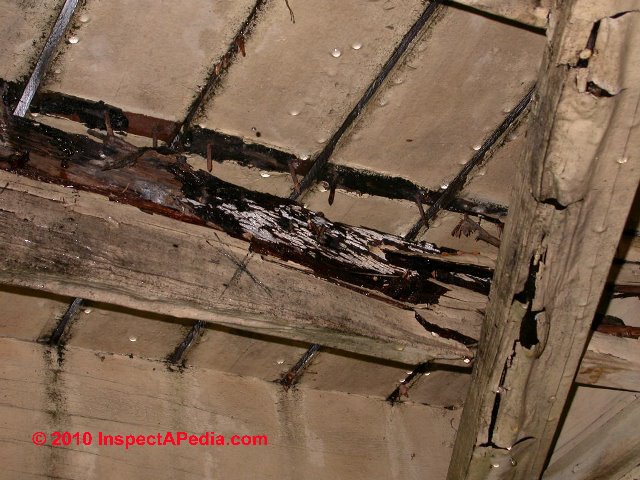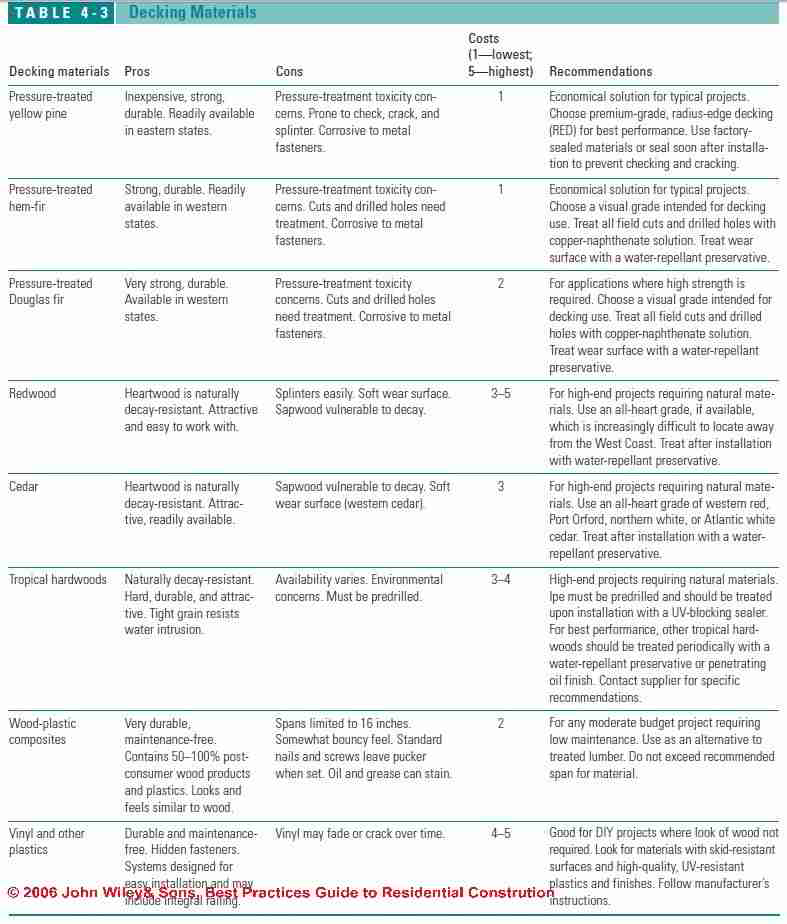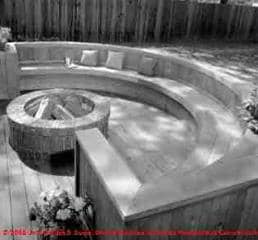 Rot-Resistant Lumber Choices
Rot-Resistant Lumber Choices
for Deck Framing & Deck or Porch Floors
- POST a QUESTION or COMMENT about how to build a rot & decay resistant wood deck or porch
Rot resistant deck & porch lumber choices: this article discusses choices of rot or decay and insect-resistant deck framing lumber as an alternative to using pressure-treated or preservative-treated wood.
InspectAPedia tolerates no conflicts of interest. We have no relationship with advertisers, products, or services discussed at this website.
- Daniel Friedman, Publisher/Editor/Author - See WHO ARE WE?
Decay-Resistant Wood Species for Decks & Porches
As described in Best Practices Guide to Residential Construction (Steve Bliss, J Wiley & Sons) , Chapter Four, Best Construction Guide for Building Decks and Porches:
For a price, redwood and cedar are available in structural grades. How rot-resistant the untreated wood is depends on the amount of extractives in the wood, which is greatest in the heartwood cut from dense, old-growth trees.
To purchase all-heart, structural-grade redwood or cedar, expect to spend two to three times more than for pressure treated lumber. It is also difficult to find away from the West Coast. Left untreated, even the heartwood of these species is not recommended for ground contact.
Guide to Plastic Alternatives for Deck & Porch Construction
Structural lumber products made of recycled plastics are starting to make their way into the marketplace and are turning up as railroad ties, dock components, and park walkways.
Since there are few standards available for these products, designers and installers will need to rely on manufacturer data for structural characteristics.
One product, TriMax (TriMax of Long Island), is made of recycled plastic and fiberglass and has compression and horizontal-shear strength similar to treated yellow pine. Like most plastic products, however, the material is more flexible than wood due to a low modulus of elasticity. This means spans must be small and the structure may have a bouncy feel.
Choices of Deck & Porch Surface & Flooring Materials
Horizontal deck surfaces take a beating. Rain and snow, exacerbated by wet-dry and freeze-thaw cycles, open up widening cracks, and ultraviolet radiation breaks down wood surfaces. The more sun exposure and water a deck sees, the quicker it will deteriorate. In addition, foot traffic makes it hard to maintain protective finishes.
In choosing a decking material, look beyond its short lived original condition to its appearance and maintenance needs down the road (Table 4-3 just below). In all cases, use the best grade of material you can afford. With wood decking, select tight, straight grain, few if any knots, and low moisture content.
[Click any image or table to see an enlarged, detailed version.]
Since most wood decking materials are graded only for appearance, the grading is unregulated and grade names may be confusing. It is best to see a sample before committing to a purchase.
Choosing Pressure-Treated Wood for Decks
 Our photo (left) of severe and dangerous structural rot at a New York deck explains why using rot-resistant lumber to build deck structures and floors is appetizing. The owner tried painting this deck as it began to rot. It didn't help much.
Our photo (left) of severe and dangerous structural rot at a New York deck explains why using rot-resistant lumber to build deck structures and floors is appetizing. The owner tried painting this deck as it began to rot. It didn't help much.
Pressure-treated decking is still the most common choice due to its low cost and ready availability. As with other pressure-treated lumber products, CCA has been phased out in favor of wood treated with copper quat (ACQ) and copper azole
(see PRESERVATIVE TREATED LUMBER).
Most builders in the eastern United States choose nominal 5/4 x 6 radius-edge decking (RED), which is dressed to 1 inch thick and can span 16 inches.
Western softwoods are typically sold as 2x4 or 2x6 stock and can span up to 24 inches. For fully exposed decks, particularly those with south-facing exposure, use the best grade available, generally called Premium in southern pine and Patio 1 or Dex in Western species. T
he radiused edges on RED stock make an attractive deck surface and help prevent splintering.
Many homeowners become disappointed with pressure treated decking when they discover that it must be treated regularly to prevent cupping, checking, and warping.
Except where the decking is under a roof and well protected from sun and rain, it must be treated with a water-repellant sealer or a semitransparent penetrating stain to prevent problems.
It is important to finish the wood as soon as the surface is dry but before it has a chance to start cracking, allowing water to penetrate and do additional damage
(see DECK FINISHES COATINGS PRESERVATIVES)
A few premium products come factory pretreated with a sealer that has penetrated the wood surface and should outlast on-site sealing.
Decay-Resistant Species for Deck & Porch Floor Surfaces
Until the recent introduction of synthetic decking materials, the only viable alternatives to pressure-treated lumber were naturally decay-resistant wood species, such as redwood and cedar. A number of tropical hardwoods are now available to deck builders as well.
Redwood and Cedar Deck & Porch Flooring
The most decay-resistant materials are cut from the dense heartwood of old-growth trees, which is expensive and increasingly rare. In redwood, the lighter colored sapwood offers moderate resistance to decay.
Cedar sapwood is even less resistant. If possible, choose all-heart grades for exposed areas (see Figure 4-1 above).
The two most commonly used cedar types are western red cedar and Alaska cedar, sometimes sold as Alaska cypress. Western red cedar is relatively soft and easily dented, but dimensionally stable. Yellow cedar is stronger and has a harder surface; but it is prone to shrinkage movement, so it is best purchased kiln-dried.
Other less common cedar species suitable for decking include Port Orford cedar, a strong, dense wood from southern Oregon, and northern white and Atlantic white cedar.
Redwood and cedar should, at a minimum, be treated regularly with water repellants to protect against cupping, checking, and cracking.
 Occasional treatment with a water-repellant preservative will increase the service life.
Occasional treatment with a water-repellant preservative will increase the service life.
Even then, the wood will weather to a silver gray like nearly all wood decking products. For clients who want to preserve the original wood color, the best option is to use an oil-based semitransparent stain with pigments that resemble the desired color.
Our photo of decay at a cedar deck (above/left) shows the condition of a rot-resistant structure after 20 years in a shaded yard with no maintenance having been performed.
Tropical Hardwoods for Deck & Porch Flooring
A number of tropical hardwoods are becoming increasingly available as decking materials, typically sold as nominal 1x4 or 5/4 x6 stock, which can span 16 inches and 24 inches, respectively.
The most widely available hardwood decking now is LPE, a group of dense teak like woods sometimes marketed under the brand name Pau Lope and reported to have a life expectancy in outdoor use of up to 40 years.
Another option for rot-resistant deck construction, Cambara, is somewhat less dense and lighter in color than Ipe, but it also offers excellent resistance to decay and insects [and was recommended in Best Practices].
Both Pau Lope and Cambara are typically knot-free with a tight grain pattern that helps keep out water.
Brazilian wood species recommended for deck construction: Cumaru, IPE, Itauba, Tatajuba, Jarana, Muricatiara, Macaranduba
Thanks to a Brazilian reader who is a deck builder we are informed that there are better choices for rot resistant deck construction:
I have read in your article the suggestion to use CAMBARA as a good wood for decking. For us here in Brazil, CAMBARA is considered a very bad quality wood in all aspects and is used only in low price housing. All Brazilian deck installers I know would [never] consider using CAMBARA as deck material.
Our company sells and builds deck in Brazil for 13 years. We use several good Brazilian species to build our decks such as CUMARU - IPE - ITAUBA - Tatajuba - JARANA - MUIRACATIARA - MAÇARANDUBA etc. - Sergio Roda, Rhodmann Hardwood Flooring, Brazil
[Mr. Roda represents Rhodmann Hardwood Flooring, a Brazilian supplier whose contact information we provide below atReferences or Citations . - Ed. We note that the wood species recommended by Mr. Roda may not all be available in North America]
They are strong, dense, and highly resistant to decay and insects, making them ideal for deck surfaces. In general, these woods will outlast the redwood and cedar available today and should require only periodic treatment with a UV-blocking water repellant or a penetrating oil finish such as Penofin (Performance Coatings Inc.). Like most hardwoods, Ipe and cambara cut slowly and must be predrilled for screws.
A third tropical hardwood group, sometimes marketed as maranti, is more commonly known as lauan or Philippine mahogany. This wood offers moderate resistance to decay and insects and requires periodic treatment with a water repellant preservative.
With all tropical hardwoods, there are valid concerns about the wood’s origin and the impact of its harvesting on the world’s rainforests. Fortunately, there are established third-party certification organizations that track the “chain of custody” of hardwood products and certify that they were harvested using sustainable logging practices. Contact the Forest Stewardship Council or the Smartwood Program for more information (see DECK & PORCH PRODUCTS).
- - Adapted with permission from Best Practices Guide to Residential Construction (Steve Bliss, J Wiley & Sons) .
at SYNTHETIC DECK BOARDS, COMPOSITE PLASTIC VINYL we discuss wooden deck board alternatives such as Trex®, TimberTech®, wood-plastic composites, and plastic or vinyl decking products.
This article series includes excerpts or adaptations from Best Practices Guide to Residential Construction (Steve Bliss, J Wiley & Sons) , by Steven Bliss, courtesy of Wiley & Sons.
Also see our BOOK REVIEW of that book.
...
Reader Comments, Questions & Answers About The Article Above
Below you will find questions and answers previously posted on this page at its page bottom reader comment box.
Reader Q&A - also see RECOMMENDED ARTICLES & FAQs
Reader Comment: check the wood species not just the treatment method:
Jim Sanders said: Thanks for the advice.
It's important to look into the species of wood being used for your project before committing. You'd hate to run into any nasty surprises. - (Apr 28, 2015)
...
Continue reading at PRESERVATIVE TREATED WOOD LIFE or select a topic from the closely-related articles below, or see the complete ARTICLE INDEX.
Or see these
Recommended Articles
- CARPENTER ANTS
- COMPOSITE LUMBER DURABILITY
- DECK & PORCH CONSTRUCTION - home
- DECK FLASHING LEAKS, ROT
- MERULIPORIA HOUSE EATING FUNGUS
- MOLD CONTAMINATION IN BUILDINGS - home
- NEW PRESERVATIVES & CORROSION where we describe structural fasteners designed for use in pressure-treated lumber.
- PRESERVATIVE TREATED LUMBER
- PRESERVATIVE TREATED WOOD LIFE
- ROT RESISTANT LUMBER
- ROT, DECK FLASHING ERRORS
- ROT, FUNGUS, TERMITES
- ROT, TIMBER FRAME - assess the extent of wood timber rot or insect damage.
- SYNTHETIC & COMPOSITE DECK BOARDS
- WOOD STRUCTURE ASSESSMENT
Suggested citation for this web page
ROT RESISTANT LUMBER at InspectApedia.com - online encyclopedia of building & environmental inspection, testing, diagnosis, repair, & problem prevention advice.
Or see this
INDEX to RELATED ARTICLES: ARTICLE INDEX to BUILDING DECKS & PORCHES
Or use the SEARCH BOX found below to Ask a Question or Search InspectApedia
Or see
INDEX to RELATED ARTICLES: ARTICLE INDEX to BUILDING STRUCTURES
Or use the SEARCH BOX found below to Ask a Question or Search InspectApedia
Ask a Question or Search InspectApedia
Try the search box just below, or if you prefer, post a question or comment in the Comments box below and we will respond promptly.
Search the InspectApedia website
Note: appearance of your Comment below may be delayed: if your comment contains an image, photograph, web link, or text that looks to the software as if it might be a web link, your posting will appear after it has been approved by a moderator. Apologies for the delay.
Only one image can be added per comment but you can post as many comments, and therefore images, as you like.
You will not receive a notification when a response to your question has been posted.
Please bookmark this page to make it easy for you to check back for our response.
IF above you see "Comment Form is loading comments..." then COMMENT BOX - countable.ca / bawkbox.com IS NOT WORKING.
In any case you are welcome to send an email directly to us at InspectApedia.com at editor@inspectApedia.com
We'll reply to you directly. Please help us help you by noting, in your email, the URL of the InspectApedia page where you wanted to comment.
Citations & References
In addition to any citations in the article above, a full list is available on request.
- Best Practices Guide to Residential Construction, by Steven Bliss. John Wiley & Sons, 2006. ISBN-10: 0471648361, ISBN-13: 978-0471648369, Hardcover: 320 pages, available from Amazon.com and also Wiley.com. See our book review of this publication.
- Decks and Porches, the JLC Guide to, Best Practices for Outdoor Spaces, Steve Bliss (Editor), The Journal of Light Construction, Williston VT, 2010 ISBN 10: 1-928580-42-4, ISBN 13: 978-1-928580-42-3, available from Amazon.com
- Prescriptive Residential Wood Deck Construction Guide, based on the 2009 International Residential Code, American Forest & Paper Association, Inc., provided by reader Mark Morsching from Everflashing.
- Sergio Roda, personal communication to D Friedman 1/10/2014, Email: sroda@rhodmann.com.br Website: http://rhodmann.com.br/
Rhodmann Hardwood Flooring. The company's website does not provide direct contact information such as telephone or mailing address. Quoting from the company's website:
RHODMANN Hardwood Inc deals with companies supplying the finest wood products to South American and European countries for more than 10 years. ... Since wood is our business, our company is committed to preserve our natural resources by carefully selecting and harvesting threes in strict accordance with IBAMA's (Brazilian Agency for Environment Protection) regulations and requirements. - Manual for the Inspection of Residential Wood Decks and Balconies, by Cheryl Anderson, Frank Woeste (Forest Products Society), & Joseph Loferski, October 2003, ISBN-13: 978-1892529343,
- In addition to citations & references found in this article, see the research citations given at the end of the related articles found at our suggested
CONTINUE READING or RECOMMENDED ARTICLES.
- Carson, Dunlop & Associates Ltd., 120 Carlton Street Suite 407, Toronto ON M5A 4K2. Tel: (416) 964-9415 1-800-268-7070 Email: info@carsondunlop.com. Alan Carson is a past president of ASHI, the American Society of Home Inspectors.
Thanks to Alan Carson and Bob Dunlop, for permission for InspectAPedia to use text excerpts from The HOME REFERENCE BOOK - the Encyclopedia of Homes and to use illustrations from The ILLUSTRATED HOME .
Carson Dunlop Associates provides extensive home inspection education and report writing material. In gratitude we provide links to tsome Carson Dunlop Associates products and services.



